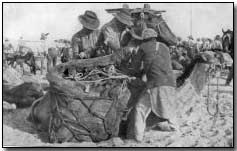Battles - The Second Battle of Gaza, 1917
 Having failed in his first
attempt to capture Gaza on 26-27 March 1917, Sir Archibald Murray,
commander of British-led forces in the region, was obliged to contemplate an
early renewal of hostilities as a direct consequence of the manner of his
report of the initial action to Britain's War Office.
Having failed in his first
attempt to capture Gaza on 26-27 March 1917, Sir Archibald Murray,
commander of British-led forces in the region, was obliged to contemplate an
early renewal of hostilities as a direct consequence of the manner of his
report of the initial action to Britain's War Office.
At best a draw Murray nevertheless conveyed the impression to London of a clear-cut British victory. While British losses of 4,000 were reported accurately Murray trebled details of Turkish casualties, which in the event were lower than his own, at 2,400. London - under the mistaken impression that Murray was on the verge of a notable breakthrough - consequently ordered him to re-engage his forces, this time with Jerusalem as the ultimate aim.
A tall order, one made immeasurably more difficult now that the commander of Gaza's permanent garrison - German General Kress von Kressenstein - was alerted to British intentions. The British had very nearly caught Kressenstein's forces by surprise during the first encounter, aided by a dense sea fog, but was saved from defeat by a serious misjudgement by Murray's subordinate commander Sir Charles Dobell.
Thus the battle was renewed on 17 April 1917. In the interim meanwhile the Turks had extended their formidable garrison defences south-east along the road to Beersheba.
Dobell chose to launch a frontal assault upon Kressenstein's force of 18,000 by three British infantry divisions aided by eight heavy Mark I tanks and 4,000 gas shells. Unable to extract anything more than minor gains in spite of a two-to-one manpower advantage, chiefly on account of complex and effective Turkish defensive lines, Dobell called off the patently unsuccessful attack on the third day. British casualties were heavy: 6,444 men, with Turkish losses under a third of that figure.
In the aftermath of the British defeat Kressenstein favoured a counter-attack against Murray but was over-ruled by his more cautious commander Djemal Pasha.
Murray, aware of the likely reaction in London to the attack's failure relieved Dobell of command, with cavalry General Chetwode taking his place. Nevertheless shocked officials in London took the opportunity to purge the high command with Murray himself being recalled to London.
In his stead was sent Sir Edmund Allenby, another British general whose star appeared to be on the wane. (Correctly) regarding his redeployment from the Western Front to Palestine as a sign of failure - he was never on easy terms with BEF Commander-in-Chief Sir Douglas Haig - Allenby engineered a spectacular revival of his and his army's fortunes in a series of comprehensive British victories in Palestine.
It began with triumph at the Third Battle of Gaza in October/November 1917.
To view maps charting the course of the three Gaza battles click here; and here; and here.
Photograph courtesy of Photos of the Great War website
"Toc Emmas" was slang for trench mortars.
- Did you know?
